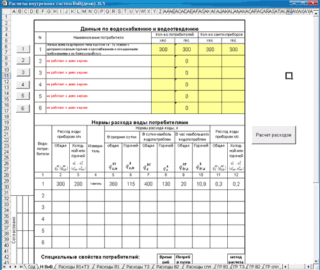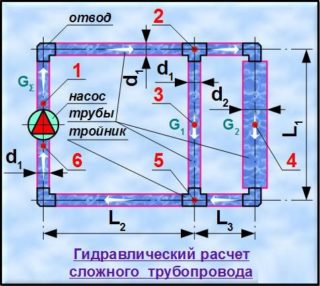When laying water mains, the most difficult thing is to calculate the throughput of pipe sections. Correct calculations will ensure that the water flow rate is not too large and its pressure does not decrease.
- The importance of correct calculations
- What determines the permeability of the pipe
- Calculation methods
- How to calculate bandwidth
- Calculation based on pipe section
- Calculation based on the temperature of the coolant
- Searching data depending on pressure
- Hydraulic calculation according to Shevelev
- Applying formulas
The importance of correct calculations
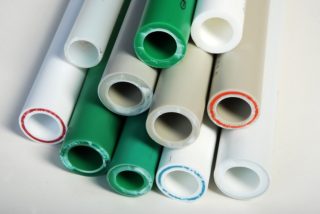
When designing a cottage with two or more bathrooms or a small hotel, it is necessary to take into account how much water the pipes of the selected section can supply. After all, if the pressure in the pipeline drops with a large consumption, this will lead to the fact that it will be impossible to take a shower or a bath normally. If a problem arises in a fire, you may even lose your home. Therefore, the calculation of the passability of highways is carried out even before the start of construction.
For small business owners, it is also important to know the throughput rates. Indeed, in the absence of metering devices, utilities, as a rule, present an invoice for water consumption to organizations according to the volume passed by the pipe. Knowing the data on your water supply will allow you to control water consumption and not pay extra.
What determines the permeability of the pipe
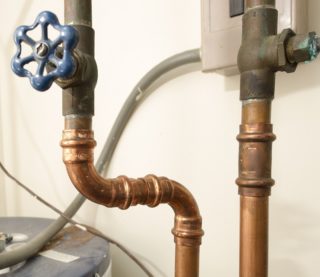
The permeability of pipe sections is a metric value that characterizes the volume of liquid passed through the pipeline for a certain time interval. This indicator depends on the material used in the manufacture of pipes.
Plastic pipelines maintain almost the same permeability throughout the entire operating period. Plastic, in comparison with metal, does not rust, thanks to this, the lines do not become clogged for a long time.
For metal models, the throughput decreases year after year. Due to the fact that pipes rust, the inner surface gradually flakes off and becomes rough. Because of this, much more plaque forms on the walls. In particular, hot water pipes clog up quickly.
In addition to the material of manufacture, the permeability also depends on other characteristics:
- The length of the plumbing. The greater the length, the lower the flow rate due to the influence of the friction force, and the pressure also decreases accordingly.
- Pipe diameter. The walls of narrow lines create more resistance. The smaller the cross-section, the worse the ratio of the flow rate to the value of the internal area in the section of a fixed length will be. In wider pipelines, water moves faster.
- The presence of bends, fittings, adapters, taps. Any fittings slow down the movement of water flows.
When determining the indicator of throughput, it is necessary to take into account all these factors in combination. In order not to get confused in numbers, it is worth using proven formulas and tables.
Calculation methods
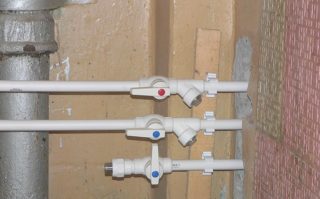
To determine the permeability of the water supply system, you can use three calculation methods:
- The physical way. To find out the indicators, formulas are used. To calculate, knowledge of several parameters is required, in particular, the size of the section of the pipe section and at what speed the water moves in the pipeline.
- Tabular method.It is the simplest one, because by picking up indicators in the table, you can immediately find out the necessary data.
- Computer programming. Such "software" is easy to find and download on the Internet. It is specially designed for finding the permeability of pipes of any system. To find out the required parameter, you need to enter the starting data into the program: material, length, quality of the coolant.
The last method, although the most accurate, is not suitable for calculating ordinary household communications. It is quite complex, and for its application you will need to know a variety of indicators. To calculate a simple network for a private house, you should resort to using an online calculator. Although not as accurate, it is free and does not need to be installed on a computer. You can get more accurate information by comparing the data calculated by the program with the table.
How to calculate bandwidth
The tabular method is the simplest. Several tables of counting have been developed: you can choose the one that is suitable depending on the known parameters.
Calculation based on pipe section
In SNiP 2.04.01-85, it is proposed to find out the amount of water consumption by the pipe circumference.
| External section of the line (mm) | Approximate amount of liquid | |
| Liters per minute | Cubic meters per hour | |
| 20 | 15 | 0,9 |
| 25 | 30 | 1,8 |
| 32 | 50 | 3 |
| 40 | 80 | 4,8 |
| 50 | 120 | 7,2 |
| 63 | 190 | 11,4 |
In accordance with the SNiP standards, the daily water consumption by one person is no more than 60 liters. This data is for a house without running water. If a water supply network is installed, the volume increases to 200 liters.
Calculation based on the temperature of the coolant
As the temperature rises, the permeability of the pipe decreases - the water expands and thereby creates additional friction.
You can calculate the required data using a special table:
| Pipe section (mm) | Bandwidth | |||
| By heat (hl / h) | By heat carrier (t / h) | |||
| Water | Steam | Water | Steam | |
| 15 | 0,011 | 0,005 | 0,182 | 0,009 |
| 25 | 0,039 | 0,018 | 0,650 | 0,033 |
| 38 | 0,11 | 0,05 | 1,82 | 0,091 |
| 50 | 0,24 | 0,11 | 4,00 | 0,20 |
| 75 | 0,72 | 0,33 | 12,0 | 0,60 |
| 100 | 1,51 | 0,69 | 25,0 | 1,25 |
| 125 | 2,70 | 1,24 | 45,0 | 2,25 |
| 150 | 4,36 | 2,00 | 72,8 | 3,64 |
| 200 | 9,23 | 4,24 | 154 | 7,70 |
| 250 | 16,6 | 7,60 | 276 | 13,8 |
| 300 | 26,6 | 12,2 | 444 | 22,2 |
| 350 | 40,3 | 18,5 | 672 | 33,6 |
| 400 | 56,5 | 26,0 | 940 | 47,0 |
| 450 | 68,3 | 36,0 | 1310 | 65,5 |
| 500 | 103 | 47,4 | 1730 | 86,5 |
| 600 | 167 | 76,5 | 2780 | 139 |
| 700 | 250 | 115 | 4160 | 208 |
| 800 | 354 | 162 | 5900 | 295 |
| 900 | 633 | 291 | 10500 | 525 |
| 1000 | 1020 | 470 | 17100 | 855 |
For the connection of the plumbing system, this information is not extremely important, but for heating circuits it is considered the main indicator.
Searching data depending on pressure
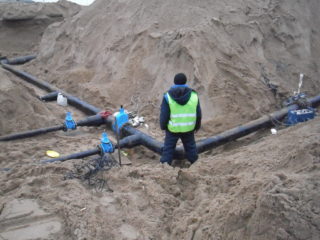
When selecting pipes for the installation of any communication network, it is necessary to take into account the flow pressure in the common line. If a high pressure head is provided, pipes with a larger cross-section must be installed than when moving by gravity. If, when selecting pipe sections, these parameters are not taken into account, and a large water flow is passed through small networks, they will make noise, vibrate and quickly become unusable.
To find the largest calculated water flow, a table of pipe throughput is used depending on the diameter and different indicators of water pressure:
| Consumption | Bandwidth | |||||||||
| Pipe section | 15 mm | 20 mm | 25 mm | 32 mm | 40 mm | 50 mm | 65 mm | 80 mm | 100 mm | |
| Pa / m | Mbar / m | Less than 0.15 m / s | 0.15 m / s | 0.3 m / s | ||||||
| 90,0 | 0,900 | 173 | 403 | 745 | 1627 | 2488 | 4716 | 9612 | 14940 | 30240 |
| 92,5 | 0,925 | 176 | 407 | 756 | 1652 | 2524 | 4788 | 9756 | 15156 | 30672 |
| 95,0 | 0,950 | 176 | 414 | 767 | 1678 | 2560 | 4860 | 9900 | 15372 | 31104 |
| 97,5 | 0,975 | 180 | 421 | 778 | 1699 | 2596 | 4932 | 10044 | 15552 | 31500 |
| 100,0 | 1000,0 | 184 | 425 | 788 | 1724 | 2632 | 5004 | 10152 | 15768 | 31932 |
| 120,0 | 1200,0 | 202 | 472 | 871 | 1897 | 2898 | 5508 | 11196 | 17352 | 35100 |
| 140,0 | 1400,0 | 220 | 511 | 943 | 2059 | 3143 | 5976 | 12132 | 18792 | 38160 |
| 160,0 | 1600,0 | 234 | 547 | 1015 | 2210 | 3373 | 6408 | 12996 | 20160 | 40680 |
| 180,0 | 1800,0 | 252 | 583 | 1080 | 2354 | 3589 | 6804 | 13824 | 21420 | 43200 |
| 200,0 | 2000,0 | 266 | 619 | 1151 | 2488 | 3780 | 7200 | 14580 | 22644 | 45720 |
| 220,0 | 2200,0 | 281 | 652 | 1202 | 2617 | 3996 | 7560 | 15336 | 23760 | 47880 |
| 240,0 | 2400,0 | 288 | 680 | 1256 | 2740 | 4176 | 7920 | 16056 | 24876 | 50400 |
| 260,0 | 2600,0 | 306 | 713 | 1310 | 2855 | 4356 | 8244 | 16740 | 25920 | 52200 |
| 280,0 | 2800,0 | 317 | 742 | 1364 | 2970 | 4356 | 8568 | 17338 | 26928 | 54360 |
| 300,0 | 3000, | 331 | 767 | 1415 | 3078 | 4680 | 8892 | 18000 | 27900 | 56160 |
The average pressure in most of the risers varies from 1.5 to 2.5 atmospheres. The dependence on the number of floors is regulated by dividing the water supply network into several branches. Water injection by means of pumps also affects the change in flow rate.
Also, when calculating the water flow through the pipe according to the table of pipe diameter and pressure values, not only the number of taps is taken into account, but also the number of water heaters, baths and other consumers.
Hydraulic calculation according to Shevelev
An example of a good model for calculations is Shevelev's table. This is a voluminous reference book. You don't have to go to the library to use it. All the data you need can be found on the World Wide Web. In addition, there are electronic programs based on Shevelev tables. It is enough to enter the required parameters to get the finished result.
Applying formulas
The application of different formulas depends on the known data. The simplest of them: q = π × d² / 4 × V.In the formula: q shows the water flow rate in liters, d is the cross-section of the pipe in cm, V is the speed indicator of the hydraulic flow advance in m / s.
The speed parameters can be taken from the table:
| Water supply type | Speed (m / s) |
| City water supply | 0,60–1,50 |
| Main pipeline | 1,50–3,00 |
| Central heating network | 2,00–3,00 |
| Pressure system | 0,75–1,50 |
When connecting additional pumping devices, it is necessary to take into account the coefficient of the created pressure. It is listed in the user manual.
Knowing what characteristics the pipes have is necessary for the competent connection of plumbing fixtures. With the correct selection of data, there will be no reason to worry that when you open the tap in the bathroom, the water in the kitchen will stop flowing or its pressure will decrease.

